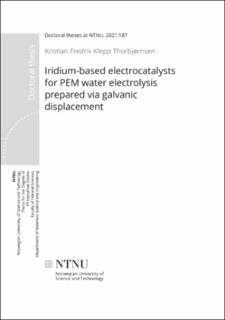| dc.description.abstract | In the transition away from non-renewable energy sources, the use of fluctuating power sources such as wind and solar are increasing. This creates a need for temporary storage of excess energy when production exceeds demand. Excess energy can be used to electrochemically convert water into hydrogen and oxygen, which has several uses and can easily be converted back to electricity in a fuel cell.
The current state of the art PEM water electrolyzers contain various expensive components, one of which is the Ir catalyst at the anode. Reducing the initial investment cost of water electrolyzers will help reducing the overall cost of an energy grid based on renewable sources. There are currently no viable replacements for the Ir catalyst at the anode, so cost reduction must necessarily come from reducing the usage without sacrificing performance.
Core/shell catalysts where Ir is applied as a thin film on a suitable substrate is a promising way to significantly reduce the Ir usage without sacrificing performance. Galvanic displacement has emerged as a suitable method to prepare such catalysts.
In this thesis, we explore how galvanic displacement can be used to prepare core/Irshell catalysts for the oxygen evolution reaction at PEM water electrolyzer anodes. We show how Ni-core/Ir-shell electrocatalysts easily can be prepared in an aqueous procedure and how the initial particle size of the Ni core is a critical parameter in the synthesis. Further, we show how Cu can be used as a template- and reducing agent to prepare Cu-core/Ir-shell electrocatalysts, where the procedure is more robust than when using Ni.
Electrocatalysts are preferably distributed on a support as nanoparticles to maximize the electrochemical surface area (ECSA) per geometric surface area. We show that insufficient electronic conductivity in the support will render the catalyst inactive.
Through galvanic displacement of Cu monolayers on Au and Pd electrodes, and Au and Pd nanoparticles with Ir, we show how thin films of Ir can be prepared on suitable substrates. The resulting catalysts are highly active towards the oxygen evolution reaction and demonstrate how not only the activity, but also the stability of the catalysts are of critical importance. Moreover, we show how hydrogen absorption into Pd can be utilized to cover Pd with metallic Ir.
We also show how microkinetic simulations are a powerful tool which allows us to model both kinetics and mass transport in galvanic displacement reaction systems.
In the end, a procedure for preparation of oxide supported core/Ir-shell electrocatalysts are suggested. | en_US |
